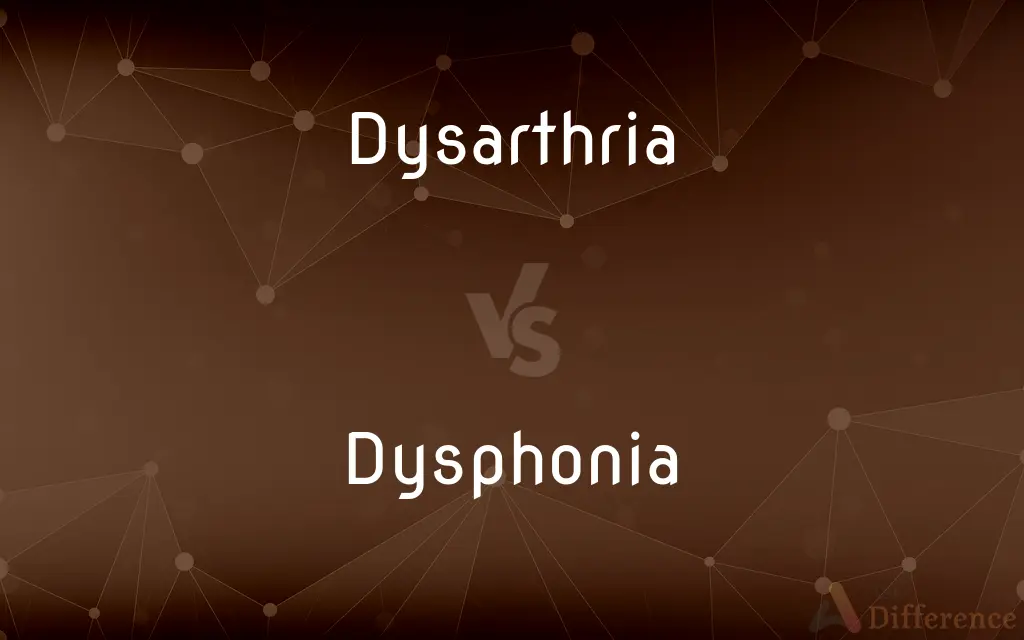Dysarthria vs. Dysphonia — What's the Difference?
By Urooj Arif & Fiza Rafique — Updated on March 7, 2024
Dysarthria affects speech articulation due to muscle weakness, while dysphonia involves voice disorders, affecting vocal quality, pitch, or volume.

Difference Between Dysarthria and Dysphonia
Table of Contents
ADVERTISEMENT
Key Differences
Dysarthria is a motor speech disorder resulting from neurological injury of the motor component of the motor-speech system. It is characterized by poor articulation of phonemes, which are the sounds of speech. In contrast, dysphonia refers to any difficulty in producing vocal sounds, usually due to a problem with the vocal cords or larynx. It can manifest as hoarseness, voice strain, changes in pitch or volume, or even the loss of voice.
Individuals with dysarthria may have speech that sounds slurred, choppy, mumbled, or breathy, depending on the type and severity of the muscle weakness or incoordination. They might also have difficulty controlling the volume, rhythm, and speed of their speech. Dysphonia, on the other hand, primarily affects the quality of the voice itself. People with dysphonia might have a hoarse or raspy voice, experience frequent voice breaks, or have trouble maintaining a steady vocal tone.
The causes of dysarthria often involve conditions that affect the brain or nervous system, such as multiple sclerosis, Parkinson's disease, amyotrophic lateral sclerosis (ALS), or cerebral palsy. Dysphonia can be caused by misuse or overuse of the voice, respiratory infections, acid reflux, smoking, or conditions that affect the vocal cords, such as nodules, polyps, or laryngitis.
Management and treatment of dysarthria usually focus on speech therapy to improve articulation, breath control, and strengthening of the muscles used in speech. For dysphonia, treatment might include voice therapy, lifestyle changes to protect the voice, medication for underlying conditions like acid reflux, or surgery for structural problems with the vocal cords.
Both dysarthria and dysphonia can significantly impact communication and quality of life, but the approaches to their management differ due to their distinct underlying mechanisms. While speech therapy is common to both, the specific techniques and goals will vary, reflecting the difference between a focus on muscle strength and coordination for dysarthria, and vocal quality and protection for dysphonia.
ADVERTISEMENT
Comparison Chart
Definition
A motor speech disorder due to muscle weakness.
A voice disorder affecting vocal quality.
Symptoms
Slurred, choppy speech; difficulty with volume, rhythm, speed.
Hoarseness, voice strain, changes in pitch or volume.
Causes
Neurological injury (e.g., stroke, brain injury, degenerative diseases).
Vocal cord issues, misuse or overuse of voice, respiratory infections.
Focus of Treatment
Improving articulation, breath control, muscle strength.
Protecting and improving vocal quality, addressing underlying conditions.
Types of Therapy
Speech therapy focused on motor skills.
Voice therapy, lifestyle changes, medication, surgery.
Compare with Definitions
Dysarthria
A neurological disorder affecting the muscles used in speech, leading to difficulties in articulation.
After the stroke, he developed dysarthria, making his speech slurred and hard to understand.
Dysphonia
Refers to disorders of the voice, including changes in pitch, volume, or quality.
Dysphonia made his voice sound hoarse and strained, especially after long meetings.
Dysarthria
Characterized by weak or uncoordinated speech muscles.
Dysarthria can cause challenges with the clarity of speech due to weakened muscle control.
Dysphonia
Primarily affects the vocal quality rather than the articulation of speech.
Despite the dysphonia affecting his vocal tone, he could articulate words clearly.
Dysarthria
Management often involves speech therapy to improve muscle function.
Regular speech therapy sessions helped her improve her articulation despite dysarthria.
Dysphonia
Often related to problems with the vocal cords or larynx.
Vocal nodules, a common cause of dysphonia, can lead to persistent hoarseness.
Dysarthria
Impacts the mechanical aspects of speech production.
Dysarthria affects the physical production of speech sounds due to impaired motor function.
Dysphonia
Can be caused by misuse of the voice, infections, or other medical conditions.
Overusing her voice during the concert series led to dysphonia, requiring vocal rest.
Dysarthria
Can result from various neurological conditions.
Conditions like Parkinson's disease and multiple sclerosis often lead to dysarthria.
Dysphonia
Treatment may include voice therapy and addressing underlying causes.
Voice therapy and treating her acid reflux helped alleviate her dysphonia.
Dysarthria
Dysarthria is a motor speech disorder resulting from neurological injury of the motor component of the motor–speech system and is characterized by poor articulation of phonemes. In other words, it is a condition in which problems effectively occur with the muscles that help produce speech, often making it very difficult to pronounce words.
Dysphonia
Difficulty in speaking, usually evidenced by hoarseness.
Dysarthria
Difficulty in articulating words, caused by impairment of the muscles used in speech.
Dysphonia
(medicine) A difficulty in producing vocal sounds.
Dysarthria
Difficulty in articulating words due to a disturbance in the form or function of the structures that modulate voice into speech; one of the first indicative symptoms of myasthenia gravis, brought about by an autoimmune response to acetylcholine receptors.
Dysphonia
A difficulty in producing vocal sounds; enfeebled or depraved voice.
Dysarthria
Impaired articulatory ability resulting from defects in the peripheral motor nerves or in the speech musculature
Dysphonia
Speech disorder attributable to a disorder of phonation
Common Curiosities
Can dysarthria be cured?
While there may not be a cure for the underlying neurological condition causing dysarthria, speech therapy can significantly improve speech function and clarity.
Is dysphonia always a sign of serious illness?
Dysphonia can result from a range of causes, from simple overuse of the voice to more serious conditions affecting the vocal cords. A thorough evaluation is necessary to determine the cause.
What lifestyle changes can help manage dysphonia?
Lifestyle changes for managing dysphonia include staying hydrated, avoiding screaming or whispering, reducing throat clearing, quitting smoking, and managing acid reflux if present.
How does dysphonia affect daily life?
Dysphonia can impact professional and personal communication, leading to social withdrawal, frustration, and in some cases, vocational challenges.
Can dysarthria and dysphonia occur together?
Yes, it's possible for an individual to have both conditions, especially if there are comprehensive neurological or other systemic issues affecting both speech and voice.
What are the main differences between dysarthria and dysphonia?
Dysarthria is a motor speech disorder that affects articulation due to muscle weakness, while dysphonia is a voice disorder that impacts vocal quality, pitch, or volume.
Is it common for children to have dysarthria or dysphonia?
Both conditions can occur in children, often resulting from congenital conditions, neurological disorders, or vocal misuse.
How are dysarthria and dysphonia diagnosed?
Both conditions are typically diagnosed by specialists such as speech-language pathologists or otolaryngologists, through clinical evaluations and possibly imaging or endoscopic studies.
Can stress cause dysphonia?
Yes, stress and tension can contribute to dysphonia by straining the vocal cords and affecting voice production.
What are common treatments for dysarthria?
Treatments for dysarthria often include speech therapy exercises to strengthen muscles, improve breath control, and enhance articulation.
Can surgery correct dysphonia?
In cases where dysphonia is caused by structural issues with the vocal cords, such as nodules or polyps, surgery may be considered as a treatment option.
Are there any technological aids to help with dysarthria?
Yes, there are various assistive communication devices and software applications designed to help individuals with dysarthria communicate more effectively.
Can singing help with dysphonia?
In some cases, controlled singing under the guidance of a voice therapist can help strengthen the vocal cords and improve voice quality in individuals with dysphonia.
How long does it take to see improvement in dysarthria or dysphonia with therapy?
Improvement timelines can vary widely depending on the underlying cause, severity, and individual response to therapy. Consistent and tailored therapy is key to progress.
What role does medication play in treating dysarthria or dysphonia?
Medication may be used to manage underlying conditions contributing to dysarthria or dysphonia, but direct treatment often involves therapy and lifestyle changes.
Share Your Discovery

Previous Comparison
Supernatant vs. Infranatant
Next Comparison
Modelize vs. ModelAuthor Spotlight
Written by
Urooj ArifUrooj is a skilled content writer at Ask Difference, known for her exceptional ability to simplify complex topics into engaging and informative content. With a passion for research and a flair for clear, concise writing, she consistently delivers articles that resonate with our diverse audience.
Co-written by
Fiza RafiqueFiza Rafique is a skilled content writer at AskDifference.com, where she meticulously refines and enhances written pieces. Drawing from her vast editorial expertise, Fiza ensures clarity, accuracy, and precision in every article. Passionate about language, she continually seeks to elevate the quality of content for readers worldwide.














































